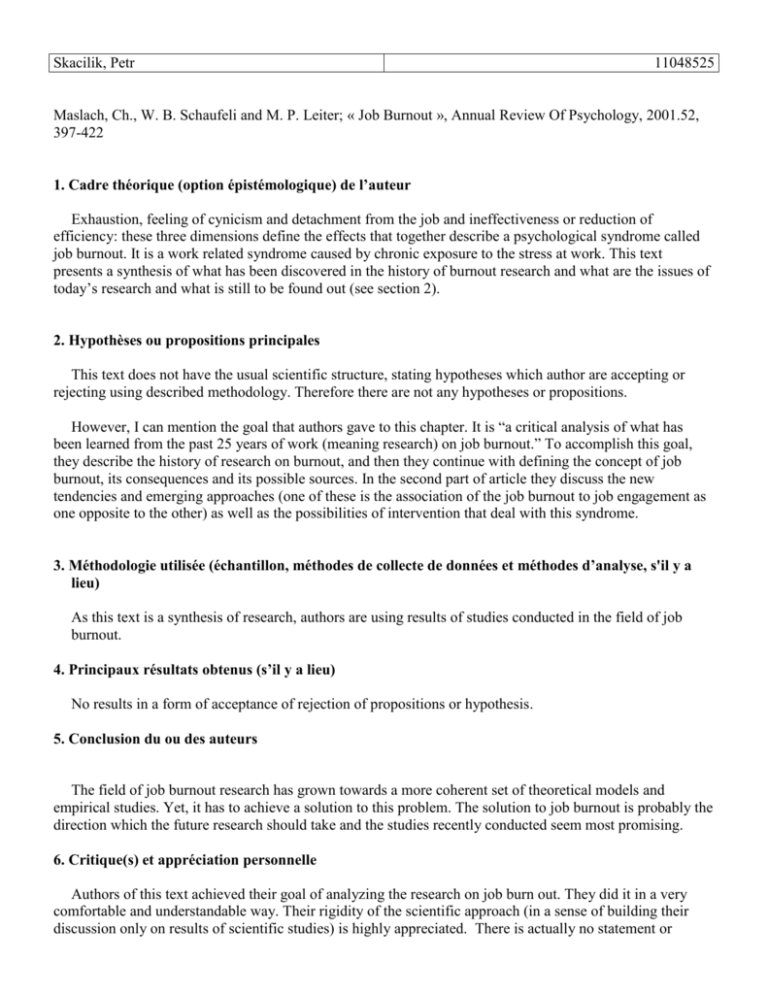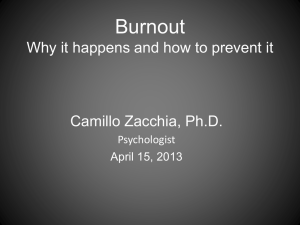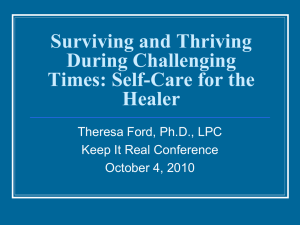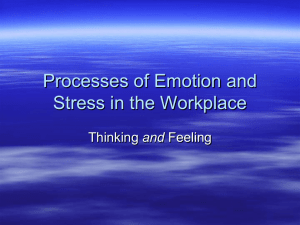Job burnout. Annual Review of Psychology, 52, 397
advertisement

Skacilik, Petr 11048525 Maslach, Ch., W. B. Schaufeli and M. P. Leiter; « Job Burnout », Annual Review Of Psychology, 2001.52, 397-422 1. Cadre théorique (option épistémologique) de l’auteur Exhaustion, feeling of cynicism and detachment from the job and ineffectiveness or reduction of efficiency: these three dimensions define the effects that together describe a psychological syndrome called job burnout. It is a work related syndrome caused by chronic exposure to the stress at work. This text presents a synthesis of what has been discovered in the history of burnout research and what are the issues of today’s research and what is still to be found out (see section 2). 2. Hypothèses ou propositions principales This text does not have the usual scientific structure, stating hypotheses which author are accepting or rejecting using described methodology. Therefore there are not any hypotheses or propositions. However, I can mention the goal that authors gave to this chapter. It is “a critical analysis of what has been learned from the past 25 years of work (meaning research) on job burnout.” To accomplish this goal, they describe the history of research on burnout, and then they continue with defining the concept of job burnout, its consequences and its possible sources. In the second part of article they discuss the new tendencies and emerging approaches (one of these is the association of the job burnout to job engagement as one opposite to the other) as well as the possibilities of intervention that deal with this syndrome. 3. Méthodologie utilisée (échantillon, méthodes de collecte de données et méthodes d’analyse, s'il y a lieu) As this text is a synthesis of research, authors are using results of studies conducted in the field of job burnout. 4. Principaux résultats obtenus (s’il y a lieu) No results in a form of acceptance of rejection of propositions or hypothesis. 5. Conclusion du ou des auteurs The field of job burnout research has grown towards a more coherent set of theoretical models and empirical studies. Yet, it has to achieve a solution to this problem. The solution to job burnout is probably the direction which the future research should take and the studies recently conducted seem most promising. 6. Critique(s) et appréciation personnelle Authors of this text achieved their goal of analyzing the research on job burn out. They did it in a very comfortable and understandable way. Their rigidity of the scientific approach (in a sense of building their discussion only on results of scientific studies) is highly appreciated. There is actually no statement or proposition that would not be supported by a result of research. They also use studies that rejected certain hypothesis or propositions and if a certain hypothesis was never proved or refused they claimed so. There are two remarks. The first one is that in some part the discussion should go deeper to explain certain effects or methods. The most obvious is the discussion on the assessment of job burnout with MBI (Maslach burnout inventory) method. Authors explained the capacity of this methodology but they should include brief description of how does it works. I think that it is important because this technology is linked later in the text to other issues concerning job burnout. The second remark points to the conclusion of the text. Authors state: “Our goal has been to look at the past and the future of burnout research.” I have a feeling that the debate about the future issues of burnout research is somewhat missing. They are discussing the recent emerging studies that “have a potential to make a major breakthrough”. But there studies where published at least two years before this text. Authors do not say what are the possible fields which the future research should treat. Nevertheless, I highly appreciate this article as it provided very clear and comprehensible analyses of job burnout. They very well explained what are the effect of burnout, where are the origins and how does it emerge. They also shortly discussed how to treat this syndrome but it seems that there is still a lot of work to do in this field. 7. Citation(s) intéressante(s) tirée(s) du texte Definition of burnout: page 399 “… burnout as a psychological syndrome in response to chronic interpersonal stressors on the job. The three key dimensions of this response are an overwhelming exhaustion, feeling of cynicism and detachment from the job, and sense of ineffectiveness and lack of accomplishment.” Multidimensional theory: page 402 “… underlying consensus about three core dimensions of the burnout experience… … led to development of multidimensional theory of burnout” Symptoms of job burnout: page 404 “five common elements… (a) There is a predominance of dysphoric symptoms… …(b) The emphasis is on mental and behavior symptoms… …(c) Burnout symptoms are work-related. (d) … affects normal persons ...”









